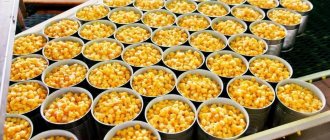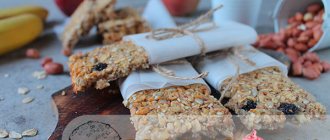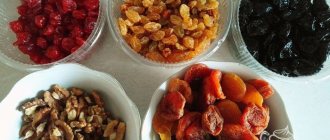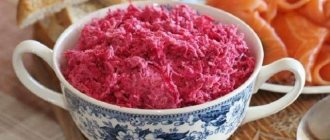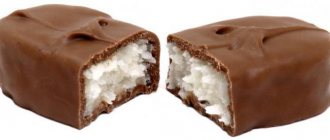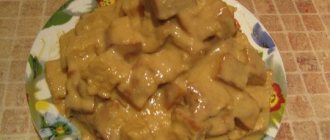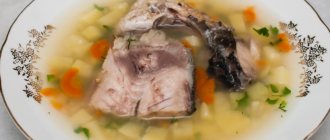How many calories are in raspberries
Tasty, juicy raspberries delight gardeners already in mid-summer, and sometimes even earlier. Depending on the variety, the berries can have different colors, from almost white to bright red. And the shape of the fruit may differ. But many are afraid to eat it in large quantities, considering it high in calories. This article details how many calories are in raspberries, fresh, dried, frozen, and processed.
How many calories are in raspberries
Almost everyone loves raspberries. This is a healthy berry recommended for consumption by people of all ages due to its rich vitamin and mineral composition. Raspberries can improve the functioning of the gastrointestinal tract and increase the tone of the body. But are there many calories in fresh raspberries? Most people who go on diets deliberately refuse the healthy berry, considering it high in calories, but in fact, 100 grams of raspberries contain only 46 kcal. To make it easier to navigate, you can calculate the calorie content depending on the serving.
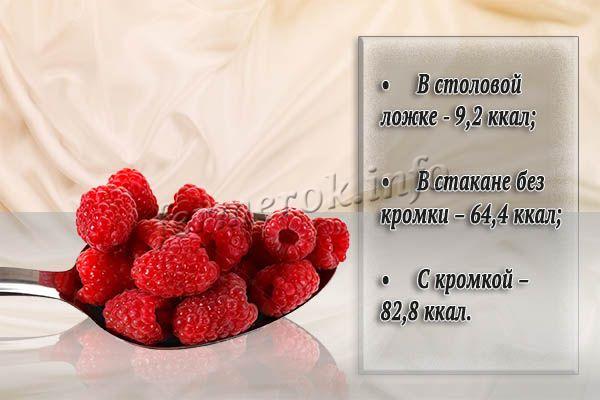
How many calories are in fresh raspberries?
- A tablespoon of raspberries contains only 9.2 kcal;
- In a glass without a rim - 64.4 kcal;
- With edge - 82.8 kcal.
It should be borne in mind that raspberries are a filling product. You can't eat a lot of it because of its high nutritional value. So this is ideal as a snack or breakfast. You can eat it fresh or make healthy juice or fresh juice. A homemade sugar-free drink will have a calorie content of about 36 kcal, due to the fact that it will not contain seeds. In comparison, juice from the store contains on average 100 kcal per 100 grams.
But this product is not stored for long, so it is advisable to use it immediately after purchase or collection from the site. Alternatively, if there is a lot of harvest, but it is not possible to process it in the near future, you can freeze or dry the raspberries. Both options are simple and convenient, but the calorie content of such a product will change.
The importance of raspberry root for the human body
Raspberry roots, like the berry and leaves, have the same powerful healing effect on the body. But the concentration of useful components, vitamins, and other biologically active substances is higher. Remedies from the roots are good for exacerbation of hemorrhoids, which are accompanied by severe inflammation and bleeding.
Depending on the health problem, the use of raspberry roots may vary slightly:
- For bronchial asthma. 50 grams of roots must be crushed, poured with a liter of water and boiled for an hour. Afterwards the broth is cooled and filtered. You should take 1-2 tbsp at a time. spoons, used 5-8 times per day;
- Inflammation of the lymph nodes. Raspberry root, fir paws and natural honey are placed in the container. All components are mixed in equal proportions. Afterwards everything is placed on low heat and boiled for 8 hours. Take 1 tbsp at a time. spoon. You need to use the product up to 5-6 times a day.
Calorie content of dried raspberries
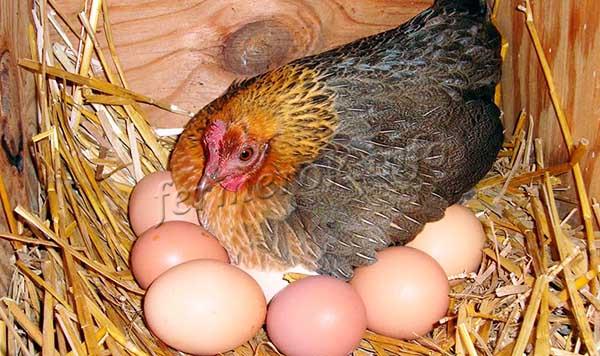
The main benefit of dried raspberries is the preservation of taste and aroma. The dried berries themselves smell very pleasant and taste rich and sweet. But you need to eat them carefully because of the seeds. So most often dried raspberries are simply used to prepare winter drinks and medicines.
Dry raspberries weigh less than fresh ones due to the fact that they lack moisture. But fresh berries contain up to 85% water! For this reason, calorie content increases. 100 grams of dried raspberries contain up to 241 kcal. It is much healthier due to the richness of its composition, but only if it is dried correctly.

Calorie content of dried raspberries
Drinks made from dried raspberries have an anti-inflammatory, diaphoretic effect, they remove symptoms of diseases, help to recover faster after illnesses, and activate the body's defenses. For this reason, it is recommended to use them in winter, when the body is weakened.
You can buy dried raspberries, but their price is usually high. It is much easier to dry raspberries at home, on your own. This is done outdoors, in an oven or in special dryers. The main rule is not to increase the temperature by more than 60 degrees, otherwise dried berries will not have any benefit to the body.
Benefits and harms in diseases
What is the main purpose of eating raspberries - what health benefits and harms does it bring? Raspberry bushes are not just sweet berries, but also a medicine that helps alleviate the condition of a number of diseases, eliminate symptoms and direct all the body’s defenses to fight the disease. Like any effective remedy, raspberries can bring not only benefits, but also cause harm. In what cases is it harmful:
- urolithiasis disease;
- kidney disease;
- allergy;
- individual intolerance to the product;
- children under 2 years of age.
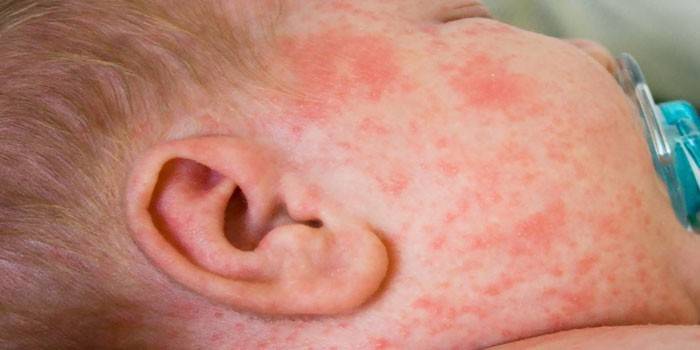
For pancreatitis
It is not recommended to use the product in the acute phase of pancreatitis (inflammation of the pancreas) due to the acids contained in raspberry seeds, which are harmful and irritate the gastric mucosa. Filtered raspberry compotes and diluted raspberry juices can be introduced into the patient’s diet from 10-15 days. In case of chronic pancreatitis, a person is allowed to consume fresh berries and jam in moderation.
For diabetes
A person who has diabetes is allowed to eat black raspberries every day, but in limited doses. The exact norm that is safe for the patient is determined by the attending physician. Berries have a low glycemic index, which means that the product does not cause a sharp increase in blood sugar levels. The healing plant does not cause harm, but has a beneficial effect on the body of a patient with diabetes, as it reduces body weight, stabilizes blood pressure and removes fluid.
For a cold
Raspberry jam is an ancient medicine that has diaphoretic properties and helps cope with the unpleasant symptoms of colds. The natural medicine has antipyretic, anti-inflammatory and antiviral properties. When you have a cold, raspberry lowers body temperature (due to salicylic acid) and causes profuse sweating. The berry owes its antimicrobial effect to tannins (anthocyanins).
For gastritis
Garden raspberries cause inflammation of the gastric mucosa (gastritis) and cause harm to the body, but you can prepare a decoction from the leaves of the medicinal plant. To do this, you need to brew the leaves in boiling water, leave and drink half a glass 6 times daily. If a person has low stomach acidity, then raspberry juice, squeezed from the fruit through cheesecloth and diluted with clean boiled water, will be useful.
For gout
In case of joint disease caused by impaired metabolism in the human body, it is necessary to strictly follow the diet prescribed by the doctor. Eating raspberries for gout is undesirable, since an exacerbation of the disease is possible due to the high content of purines in the composition of the plant’s fruits. Gout is characterized by increased production of uric acid. Purines are substances that, when broken down, release uric acid, which harms the body.
How many calories are in frozen raspberries?
Freezing raspberries is the easiest way to preserve berries. This method allows you to preserve the taste, shape and aroma of berries, and preserve the maximum of nutrients in them. You can eat raspberries frozen, fresh, or use them to prepare various dishes. For example, frozen raspberries are good in compotes, baked goods, ice cream and other similar dishes.

How many calories are in frozen raspberries?
The calorie content of frozen raspberries is 40-45 kcal/100 g. The sweeter the fresh berry was, the higher the calorie content it will be when frozen. You can freeze raspberries whole or grated. It is best to freeze it without additional ingredients, but at the request of the hostess, add sugar, other berries, fruits, mint or other ingredients.
Harvesting, storing and using raspberries for medicinal purposes
If you plan to use raspberries for medicinal purposes, and not just as a food product, it is better to replace traditional jam with raspberries ground with sugar. The calorie content of raspberries prepared in this way will not differ from the calorie content of raspberries in the form of jam. If you care about how many calories are in raspberries, you can use fructose instead of sugar. In this case, there will be fewer calories in raspberries with fructose, since fructose and sugar have the same calorie content, but fructose is sweeter. For one kilogram of raspberries, the consumption will be 1 kg of sugar or 600 grams of fructose.
If you want to minimize the number of calories consumed with raspberries, raspberries can be frozen or dried without using sugar. How many calories are in raspberries with this processing? About the same: the calorie content of dried raspberries is 46 kcal per hundred grams. When drying, it is better to dry the berries in the shade, without additional processing. After this, raspberries should not be added to hot tea; it is better to eat them separately (with the exception of diaphoretic teas). Freezing is done in the same way as when preparing other berries.
Dried raspberries are used for colds, flu, high blood pressure and bleeding, to prevent anemia. It can also be used as a stress reliever.
For diaphoretic tea, 2 tablespoons of dried raspberries are poured with a decoction of boiling water. The fact is that vitamin C is destroyed less at temperatures of 100 degrees and 30 degrees than at an average temperature of 60-70 degrees Celsius.
4.9 out of 5 (8 Votes)
In spring and until late autumn, we can enjoy raspberries, which have not only an attractive appearance, but also a unique taste. If you want to lose weight, but can’t give up sweets, you can perfectly replace sweets and cookies with these bright berries, which have received nationwide recognition. They can be eaten fresh, incredibly tasty desserts are prepared from them, and they are used to treat colds and infectious diseases. Meanwhile, given the presence of large amounts of sugar in the form of fructose, glucose and sucrose, many are interested in how many calories are in raspberries and how often they can be included in their diet.
Calorie content of raspberries with sugar
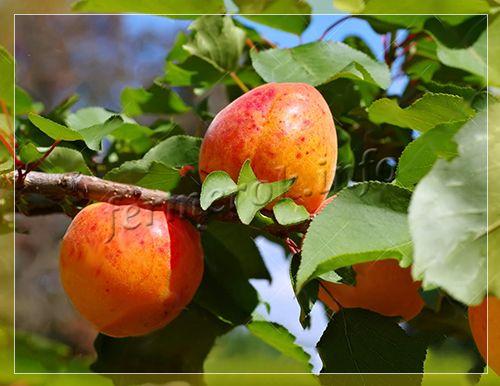
Raspberry preparations are in great demand. But depending on the type of processing, the nutritional value of the berries will vary. How many calories are in raspberries with sugar, in their juice or jam is of interest to many housewives. So this issue needs to be covered in detail.
- Raspberry juice is not very popular, but it is sometimes made. This is an expensive product, since it takes a lot of berries to make it. It is also useful if prepared at home, since it does not contain sugar (unless you add it). Homemade juice contains approximately 36 kcal per 10 grams of product if the seeds are removed. Store-bought juice will contain 90-100 kcal for every 100 g of product.
- raspberries mashed with sugar . As a rule, the berries are simply sprinkled with sugar and mashed with a spoon. This preparation is not thermally treated, which allows the maximum of nutrients in the berries to be preserved. The preparation does not last long, but how many calories are in raspberries, grated with sugar? It is due to sugar that the calorie content increases, but how high it will be depends on the concentration of sugar. With a 2:1 ratio of sugar to berries, 100 g of product will contain 281 kcal. If berries and sugar are taken 1:1, then 100 g of product will contain 222.5 kcal. If raspberries are taken with 2 times more sugar, then 100 g of the product will contain 164 kcal.

Calorie content of raspberries with sugar
- Raspberry preserves and jam are valued for their excellent taste, but they contain much less nutrients than fresh raspberries or ground raspberries with sugar. They can relieve fever, relieve headaches, and thin the blood. 100 g of raspberry jam or jam contains approximately 273 kcal.
As you can see, jam and raspberry jam are considered the most high-calorie. The more sugar and other additives in the preparations, the higher the calorie content they will be, you need to take this into account!
Counting calories
Raspberries are prepared for the winter in various ways. The calorie content of the product and its benefits depend on this. Since “grandmother’s times,” the most common method has been grinding with sugar in a 1:1 ratio. Such berries do not need to be subjected to heat treatment. Consequently, it retains many useful qualities.
The calorie content of raspberries ground with sugar is 250 kcal. The lion's share of the energy value comes from sugar, which makes the dish quite high in calories, but still healthy.
Having found out how many calories are in raspberries pureed with sugar, many will look for an alternative harvesting method that will reduce this figure. And it's not hard to find. Freezing is considered the most common method today.
The calorie content of frozen raspberries is equal to the calorie content of 100 grams of raspberries. fresh product – 46 kcal. But it should be noted that such a berry will be more sour when thawed. The problem is that glucose tends to “freeze out.” And some useful substances cannot withstand storage at sub-zero temperatures for a long time.
But we can fix the matter. You can ensure that the glucose remains in the berry in greater quantities and the raspberries are not so sour - add just a little sugar. How many calories are in raspberries frozen with a small amount of sugar depends on this amount. On average - 100 kcal if you add half the amount of sweetness.
Now about the details. Remember how your grandmothers treated you for a cold as a child. Tasty and simple - hot milk with raspberry jam. We will do things a little differently. You can add a lower-calorie product to hot milk - raspberries from the freezer or grated with sugar.
The calorie content of raspberries with milk (raspberries from the freezer) will be only 76 kcal. Now let's calculate how many calories are in raspberries with milk (berries ground with sugar). But it will turn out a little more - about 100 kcal.
If the calorie content of raspberries in sugar does not suit you, consume the product without sweetener. The sourness of thawed berries can be “quenched” with an equally sweet product – honey.
Don't miss the moment to make tasty and healthy preparations. Then your family will definitely not be left without sweets.
The total calorie content of fresh raspberries per 100 grams is 45 kcal. 100 g of berries contains:
- proteins – 0.75 g;
- carbohydrates – 8.4 g;
- fats – 0.5 g.
The composition of the berry is pleasantly surprising. The product contains sufficiently large quantities of useful organic acids, vitamins A, C, group B, as well as natural fatty oils, easily digestible sucrose and fructose, pectin, fiber, and flavonoids. Micro- and macroelement composition is represented by zinc, copper, cobalt, iron, magnesium, potassium.
The total calorie content of frozen raspberries per 100 grams is 31 kcal, that is, almost 1.5 times less than that of fresh berries. After freezing, the product contains significantly less healthy fats and carbohydrates, so we recommend that you choose fresh berries.
Calorie content of sweet dishes with raspberries
Dishes with raspberries are also often made. And depending on the type of dish, calorie content can vary greatly. Of course, it is most beneficial to eat raspberries fresh, dried or frozen, but they are also healthy and very tasty in dishes.
It’s difficult to say for sure what the calorie content of a dish will be, because it all depends on the ingredients. Sorbet is a popular, low-calorie dessert. 100 g of product contains about 74 kcal if it was made from raspberries. If we talk about pies, then on average, 100 g of product contains about 265 kcal. Muffins with raspberry jam or raspberries in dough will have a calorie content of around 300 kcal. There are more calories in raspberry puffs - 315 kcal/100 g. In various sauces for main courses and appetizers there are approximately 130 kcal per 100 grams.
Of course, these numbers are conditional. The exact calorie content depends on the components of the dish and the quantity of all components. After all, different housewives can put more or less sugar and other ingredients into the same pie, and this changes the calorie content!
Raspberries - composition, calorie content, medicinal properties and harm

Raspberries are a healthy berry, which contains a large amount of vitamin C, many micro- and macroelements. Berry is a natural source of phenolic and flavonoid substances with antioxidant properties. These compounds strengthen the immune system and prevent pathological changes in cells.
Raspberries have medicinal and beneficial properties. Not only fresh and frozen berries are useful, but also leaves, branches and even roots. During colds, people often drink tea and a decoction of dried and fresh leaves and berries. Using raspberries you can lose weight, and using berry oil made from the seeds can improve the condition and color of your skin.
Contraindications and harm
Sometimes, when consuming berries, leaves, or roots, an allergy may develop. In this case, you should avoid using products made from parts of the plant and raspberries.
You should not eat raspberries if you have the following contraindications:
- individual intolerance;
- problems with kidney activity. This is due to the strong diuretic effect that the berry has;
- bronchial asthma;
- exacerbation of gastric ulcer, gastritis.
A decoction of the leaves should not be taken if you have the following health problems:
- chronic constipation;
- stomach upsets;
- gout;
- jade.
Women who are pregnant and less than 34 weeks should not drink decoctions. Also, raspberry branches are contraindicated for people with urolithiasis and gout. Raspberries are considered a healthy berry, which contains a variety of vitamins and minerals.
It improves general condition, increases immunity, and increases the body's resistance to various diseases. But still, before consuming it, it is worth considering the basic properties, calorie content and energy value. It is useful to include berries and parts of the plant in the diet when losing weight; they help reduce excess body weight and burn fat.
Calorie content and composition of raspberries
Raspberries are an incredibly healthy berry, the consumption of which will have a positive effect on the functioning of internal organs and overall health. The calorie content of fresh raspberries per 100 g is 45 kcal. The nutrients of the product are practically not lost during cooking, with the exception of heat treatment at high temperatures.
Energy value of the berry:
- frozen raspberries without sugar – 45.4 kcal;
- dried – 115 kcal;
- an hour with raspberries (without sugar) – 45.7 kcal;
- grated raspberries with sugar – 257.5 kcal;
- jam – 273 kcal;
- compote – 49.8 kcal;
- fruit drink – 40.1 kcal.
One glass of fresh raspberries contains approximately 85.8 kcal.
Nutritional value of fresh raspberries per 100 grams:
- proteins – 0.8 g;
- fats – 0.5 g;
- carbohydrates – 8.3 g;
- water – 87.6 g;
- dietary fiber – 3.8 g;
- ash – 0.5 g;
- organic acids – 3.7 g.
The ratio of BJU per 100 g of frozen berries is similar - 1/0.6/10.4, respectively. For the dietary menu, it is recommended to use ripe fruits without additional ingredients and not subjected to heat treatment. It is also useful to include frozen raspberries in your diet; the main thing is to defrost the product naturally.
The chemical composition of berries per 100 g is presented in table form:
| Item name | Amount of raspberries |
| Iron, mg | 1,2 |
| Manganese, mg | 0,21 |
| Aluminum, mg | 0,2 |
| Copper, mg | 0,17 |
| Boron, mg | 0,2 |
| Zinc, mg | 0,2 |
| Potassium, mg | 224 |
| Phosphorus, mg | 37 |
| Calcium, mg | 40 |
| Magnesium, mg | 22 |
| Sulfur, mg | 16 |
| Chlorine, mg | 21 |
| Silicon, mg | 39 |
| Sodium, mg | 10 |
| Ascorbic acid, mg | 25 |
| Choline, mg | 12,3 |
| Vitamin PP, mg | 0,7 |
| Vitamin E, mg | 0,6 |
| Thiamine, mg | 0,02 |
| Vitamin A, mcg | 33 |
| Vitamin B2, mg | 0,05 |
| Vitamin K, mcg | 7,8 |
In addition, raspberries contain glucose in the amount of 3.9 g, as well as fructose - 3.9 g and sucrose - 0.5 g per 100 g. The berry contains a small amount of polyunsaturated fatty acids, such as omega-3 and omega -6.

Raspberry leaves contain:
- flavonoids;
- fiber;
- organic acids (fruit);
- mineral salts;
- salicylates;
- astringent and tanning compounds;
- potassium, phosphorus, iodine, magnesium and calcium.
There are resins, antioxidants and other biologically active substances necessary to maintain the vital functions of the body.
Chemical composition of raspberries
It is impossible not to pay attention to such an issue as the composition of raspberries. In its composition, this beautiful berry resembles a real treasure trove of vitamins and minerals. So, it contains:
- fiber (5-6%);
- fructose and glucose (10-12%);
- mega-valuable organic acids (malic, salicylic, ascorbic, citric, folic);
- fatty acid;
- vitamins A, beta-carotene, B1, B2, B5, B9, B6, B12, E, H, PP;
- coloring and tanning agents, pectins;
- minerals (iron, calcium, boron, zinc, potassium, magnesium, cobalt, phosphorus, copper).
It is worth noting that all of the above substances in this berry are in excellent balance with each other and are perfectly absorbed by the human body. This makes raspberries a product that meets the criteria for a low-calorie diet.
The benefits of raspberries and medicinal properties
It has been scientifically proven that daily consumption of fresh raspberries has a positive effect on well-being. The recommended daily dose is 10-15 berries.
The berry has a multifaceted healing effect on the body:
- Relieves inflammation in the joints, so raspberries are recommended for people with diseases such as arthrosis and arthritis. Berries have the most effective effect on joints in the early stages of the disease.
- Strengthens the heart muscle, cleanses blood vessels from cholesterol plaques, and normalizes blood pressure. Regular consumption of raspberries helps prevent heart disease in men and women.
- Cleanses the intestines of toxins, toxins and poisons.
- Facilitates menopause in women.
- Improves mood, strengthens the nervous system, relieves symptoms of stress.
- Improves brain function, enhances memory.
- Normalizes the functioning of the pancreas and maintains blood sugar balance
- Protects against insulin surges, so the berry is recommended for people with diabetes and obesity.
- Improves the functioning of the reproductive organs, prevents the risk of male infertility and increases fertility.
- Normalizes hormone production.
- Accelerates recovery from colds. The optimal way to consume it is raspberries with milk and honey.
In addition, systematic consumption of raspberries helps strengthen the immune system, as well as reduce the risk of atherosclerosis and cancer.
Note: Frozen and dried raspberries have the same beneficial and healing properties as fresh ones. Raspberry jam and compote have antipyretic and analgesic properties. Raspberry tea is useful during colds, but it should be brewed for no more than 3 minutes.
The benefits for the body from raspberry juice and berries, ground with sugar, are the same as from fresh fruit, but with higher calorie content. Juice can dull the feeling of hunger.
Raspberry seeds are used in cosmetology to make scrubs, face masks and creams. In addition, oils are made from the seeds that have a beneficial effect on the skin, namely: anti-inflammatory, healing and soothing.

Raspberry leaves
Raspberry leaves contain a large amount of nutrients, thanks to which both fresh and dry foliage have properties beneficial to human health. Decoctions and teas help with colds and provide:
- antipyretic effect;
- diaphoretic;
- anti-inflammatory;
- immunostimulating;
- astringent.
The foliage speeds up the healing process of wounds and stops bleeding.
During a sore throat, you can gargle with a decoction of the leaves. It will help get rid of acne on the face. Drinking the tincture is useful for inflammation of the gastrointestinal tract and to increase immunity.
Ointments are prepared from the leaves, which are used in the treatment of skin diseases such as rashes, eczema and even psoriasis.
The healing properties of brewed leaves are used in the treatment of the following diseases:
- ARVI;
- stomach ulcer;
- inflammation of the gastrointestinal tract;
- conjunctivitis;
- haemorrhoids;
- colitis;
- stomatitis and other diseases of the oral cavity.
The leaves are actively used in cosmetology to rejuvenate the skin and strengthen the hair structure.
Tea made with fermented raspberry leaves has a richer flavor and aroma, but most of the nutrients are lost during the fermentation process, making the drink less healthy than tea made from fresh or dried leaves.
Raspberry branches
The beneficial and healing effects of raspberry branches have been known since ancient times. The benefits of the plant are equally great both in fresh and dried form. Decoctions are made from the branches, tinctures are made and used as lotions for damaged areas of the body.
With the help of decoctions they treat:
- colds (including flu), cough, bronchitis and inflammation of the upper respiratory tract;
- skin diseases;
- haemorrhoids;
- stomach pain;
- heartburn;
- stomach bleeding.
Using raspberry branches, you can strengthen the immune system, as well as the walls of blood vessels. In addition, blood clotting will improve and the risk of developing atherosclerosis will be reduced.
Properties of raspberry leaves
Raspberry leaves and branches have strong medicinal properties that have been known since ancient times. The benefits of the plant are equally high in fresh and dried form. Decoctions and various tinctures are prepared from the branches; these products are used in the form of lotions that are applied to problem areas.
Decoctions of the leaves are recommended to be used to treat the following ailments:
- colds: decoctions help eliminate the flu, they relieve severe cough, bronchitis, inflammation of the upper respiratory tract;
- skin diseases;
- hemorrhoids;
- severe pain in the stomach area;
- heartburn;
- stomach bleeding.
The use of medicinal products from branches and leaves has a positive effect on the general condition; they strengthen the immune system and improve the condition of the walls of blood vessels. In addition, they normalize blood clotting and reduce the risk of developing atherosclerosis.
Raspberry as a means for weight loss
To lose weight with raspberries, you need to consume half a glass of fresh berries three times a day, half an hour before meals.
The berry is useful for weight loss for several reasons:
- has fat-burning properties due to the lipolytic enzymes contained in raspberries;
- has a low glycemic index, due to which it does not increase blood sugar levels;
- improves intestinal function and digestive process;
- has a diuretic effect on the body, due to which excess fluid is removed and swelling is relieved.
In addition to excess fluid, salt and toxins are removed from the body. During a diet, it is useful to include both fresh and frozen berries in your diet, but they must be consumed without sugar or any other sweeteners.
Calorie content of raspberries and weight loss
The caloric content of raspberries allows you to consume them during a diet
. Moreover, it contains enzymes that burn fat. The berries contain fiber, which normalizes the functioning of the gastrointestinal tract, and also removes waste and toxins from the body, resulting in the restoration of beneficial microflora. Thanks to its choleretic and diuretic properties, raspberries remove excess fluid and salt from the body. It is enough to eat raspberries daily to gradually lose weight and improve your body health.
But it should be kept in mind that raspberries have some contraindications. Firstly, it is necessary for allergy sufferers to limit its use. Secondly, people who suffer from gastritis, ulcers, gout, urolithiasis and kidney diseases should completely exclude this berry from the diet.
Popular articles
Losing weight cannot be a quick process. The main mistake of most people losing weight is that they want to get amazing results in a few days on a starvation diet. But it didn’t take a few days to gain weight! Extra pounds...
Calorie content of fresh raspberries
Fresh raspberries are a low-calorie product. Its calorie content per 100 grams varies from 47 to 55 kcal, depending on the variety and degree of ripeness of the berries. Therefore, nutritionists often advise using it when creating their menu for those who want to lose excess weight or are trying to keep it the same.

Carbohydrates in raspberries are represented by sucrose, glucose and fructose. Californian scientists have proven that fructose is more dangerous for your figure than glucose and sucrose. Therefore, those who are watching their weight should avoid berries and fruits high in fructose. Raspberries contain approximately the same amount of glucose and fructose - about 3.9 g per 100 g of pulp. There is about 0.5 g of sucrose per 100 g of product. These are not high figures. For comparison, grapes, which are considered an undesirable food for weight loss diets, contain 7.8 g of fructose and 7.7 g of glucose. A pear contains about 6.5 g of fructose, and a persimmon contains about 5.5 g.
Assessing the amount of fructose contained in raspberries, the berries can be considered safe for the figure. Especially when you compare them with bananas, grapes and persimmons - fruits that nutritionists call the “enemies of slimness.”

The calorie content of fresh raspberries depends on the plant variety and the place where it grows. It is believed that red garden raspberries, which are grown in sunny summer cottages, are sweeter than the wild variety. Wild raspberries, growing in shady areas, do not have such a sweet taste, but are more aromatic.
Yellow raspberries have an even sweeter taste. It contains not only less anthocyanins, which determine the color of fruits, but also less organic acids. But it contains more sugars. The taste of yellow raspberries is softer and richer. The calorie content of ripe berries is 49 – 50 kcal per 100 g.
But black raspberries are considered the sweetest. This variety was bred in North America, so plants with black berries are less common in vegetable gardens and front gardens in our area, but they are gradually gaining popularity among Russian gardeners. The taste of black raspberries is higher than that of red and yellow ones. Its taste is sweeter, honey. The calorie content of black berries reaches the highest level - 55 kcal per 100 g.

Fresh raspberries are a source of carbohydrates for the body. There is very little protein and fat in it. 100 g of fruit contains:
- 8.3 g carbohydrates;
- 0.8 g proteins;
- 0.5 g fat.
Thanks to the carbohydrates contained in the fruit, raspberries fill you well and ensure a long-term lack of hunger.

The effect of raspberries on the figure
Considering the calorie content per 100 grams of berries, raspberries can be considered a dietary product. And if you take into account the amount of vitamins and microelements that have a beneficial effect on metabolism in the body, it can even be called a product that promotes weight loss.
But this does not mean that you can eat it in unlimited quantities. Moderation is important in everything. For an adult, the daily norm is considered to be 70–100 g of berries; for children, a portion weighing up to 50 g will be sufficient.
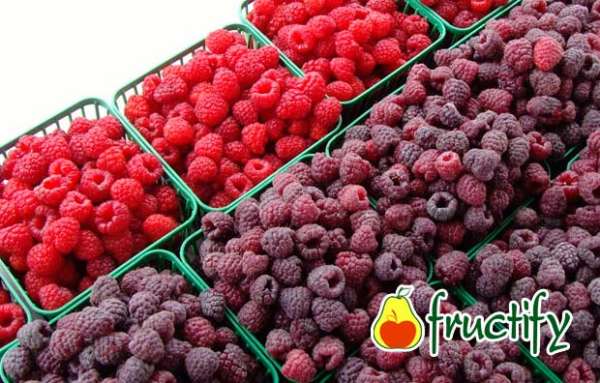
Raspberry diets
There are many variations of raspberry diets that promise quick results. These are both so-called express diets and mono-diets. The first are based on a sharp reduction in calories due to the introduction of raspberries and other low-calorie foods into the diet. Such diets allow you to lose up to 3 kg of weight in 2 – 3 days.
Mono-diets have even more stringent restrictions. When following the raspberry mono-diet, you are allowed to consume only one product - raspberries. You can drink water, green tea. As a rule, the duration of a mono-diet does not exceed 3 days. During this period you can lose up to 5 kg.

If express diets, the diet of which has a reduced caloric intake, are considered ineffective, and when returning to the usual diet, the weight returns “boomerang”, then mono-diets are considered completely dangerous to health. Excluding protein foods and fats from the diet is stressful for the body. The menu should be balanced. If a mono-diet lasts more than 3 days, there is a high probability of harming your body.
In order for weight to decrease without the body feeling a lack of micronutrients, the diet must be composed in such a way that it contains proteins, fats, and carbohydrates. To lose weight, it is enough to create a small calorie deficit. To do this, you should eat raspberries at one of your meals, for example, lunch, or replace with them the sweets that were present in the diet before the diet.
A sample weight loss menu might look like this:
- breakfast: omelet with cheese and herbs, a slice of bread with butter;
- snack: raspberries with milk;
- lunch: soup with meatballs and rice;
- dinner: fish baked with vegetables.
The benefits of raspberries for pregnant women
The invaluable composition of the berries will bring undoubted benefits to a pregnant girl for her own body and the development of the child. Experts recommend including raspberries in the usual diet of women during the lactation period. Systematic consumption will improve digestive processes, relieve urination problems and constipation. Raspberries have proven themselves to be an effective remedy for vomiting and toxicosis. The fruits have a beneficial effect on the walls of the uterus and vagina, making the tissue more elastic. As a result, childbirth will be comfortable and painless. Due to the content of fragrin in the leaves of the berries, the uterus quickly contracts during training contractions or immediately after childbirth
The decoction should be used with caution after consultation with your doctor. Otherwise, you can provoke premature birth. During the lactation period, girls are recommended to consume raspberries in small quantities.
The rich composition of berries will saturate milk with microelements, making it tasty and nutritious. The berries will significantly strengthen the protective functions of the new mother and child. Systematic use will increase the girl's milk supply. You should be careful, raspberries are an allergen, so the inclusion of the product in the diet should be gradual and in small quantities. Start including fruits in your diet with a small cup of tea with the addition of a few berries. Taking raspberries should be stopped immediately if you experience diathesis, bloating or intestinal upset.
Calorie content of dried raspberries
Deprived of moisture, freeze-dried raspberries are often used in cooking. It is added to baked goods, desserts, cereals, dairy products, and compotes and jelly are made from it. It has a rich raspberry flavor and is even sweeter than a fresh berry.
But more often, dried raspberries are used for medicinal purposes. Decoctions and infusions are prepared from it, tea is brewed, using its healing properties to fight colds, strengthen the immune system, improve heart function and the condition of blood vessels.
During drying, the berries lose about 90% of their moisture, so dried raspberries have a higher calorie content than fresh fruits. 100 g of dried berries contains about 240 kcal. If raspberries are not just dried, but pre-boiled in sugar syrup, the calorie content of the berry can increase by one and a half to two times.
If the drying conditions are met, many beneficial substances are retained in the berries, so freeze-dried raspberries are not only tasty, but also a healthy product . It is rich in vitamins C, A, E, it has a lot of potassium, magnesium, salicylic acid, and fiber.
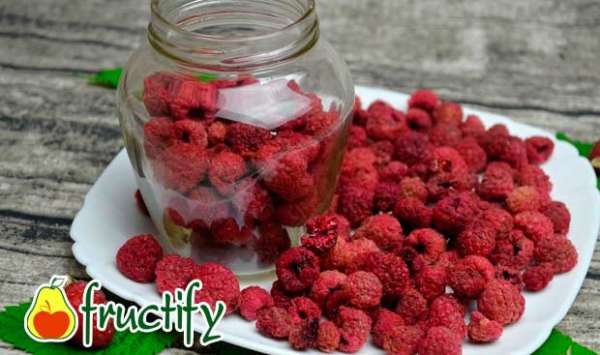
Useful properties of raspberries
First of all, it should be noted that all vegetative organs of raspberries have beneficial properties, namely leaves, inflorescences, shoots, root system and, of course, berries. Moreover, it is quite difficult to say which part of the plant is more valuable. All organs of the raspberry bush are rich in vitamin C. Most often, raspberries are used to fight infections of various kinds - both respiratory and intestinal.
- Raspberries and their leaves (decoctions and infusions from them) are also irreplaceable in cases where there is inflammation in the body, but you don’t want to take pills or you can’t. Thus, pregnant women for whom any “chemistry” is contraindicated can calm headaches, adjust their digestive system, and normalize blood sugar levels with the help of raspberry tea.
- By the way, those who cannot boast of healthy blood vessels are recommended to indulge in raspberries and drink raspberry teas.
- Women suffering from periodic heavy bleeding should also not forget about raspberries.
- Oddly enough, even with diarrhea and other intestinal disorders, it is also recommended to remember it. If you can’t eat a couple of handfuls of fresh berries, you can drink a glass of raspberry juice or syrup - the astringent effect is guaranteed.
- Against the background of mineral and vitamin richness, the low calorie content of the raspberry harvest is a real find for those who are very careful about their slimness.
Frozen berry
The easiest way to preserve raspberries in the autumn-winter period is freezing. Frozen berries, thanks to the “shock freezing” technology, retain most of the beneficial properties and taste of fresh raspberries. Freshly frozen raspberries can be consumed as an independent product or added to various dishes and drinks, for example, you can prepare a cottage cheese casserole with berries or make raspberry compote.
The calorie content of frozen berries is 40 - 45 kcal. As is the case with fresh berries, the calorie content of frozen raspberries depends on the degree of ripeness and the type of product used for preparation. The sweeter the fresh berry, the higher the calorie content of frozen raspberries.
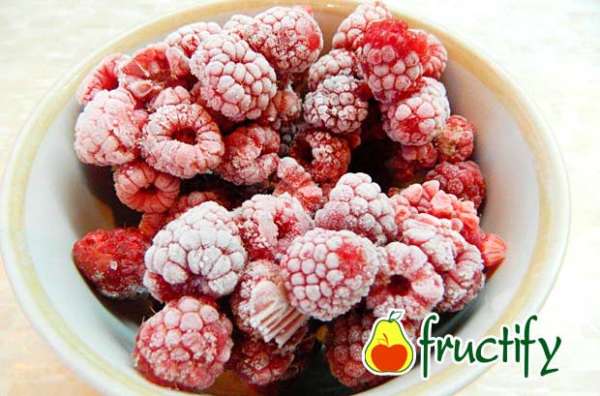
Most often, one of 2 methods of freezing raspberries is used:
- freezing whole berries: spread the raspberries in an even layer on a flat surface and put them in the freezer;
- freezing raspberries pureed with sugar: the berries are combined with granulated sugar and ground with a wooden masher, after which the puree is laid out in plastic or glass containers and placed in the freezer.
Depending on how many ingredients were used for the preparation, raspberries frozen with sugar can have a calorie content several times higher than berries frozen without sugar.
For example, if 100 g of granulated sugar was added to 300 g of berries, frozen raspberries will have a calorie content of about 135 kcal per 100 g of product. This recipe uses a 3:1 ratio. If more sugar is added, the calorie content of frozen raspberries will be even higher.
Without sugar, as a rule, whole berries are frozen. If raspberries are pureed, it is advisable to add granulated sugar to it, so that in the future the puree will be more convenient to use as a filling for pies, a component of desserts and creams.

Calorie content
The good thing about raspberries is that they can be eaten fresh, in the form of compote and jam; they are perfectly stored frozen and dry without losing their properties. During the cold season, it is frozen berries that most often end up in our kitchens, so the question of how many calories are in frozen raspberries is often heard. The calorie content of frozen raspberries is slightly higher than the calorie content of fresh berries, since they become denser when frozen. If a fresh product contains only 40-50 kcal per 100 grams of berries, then berries that have undergone rapid cooling contain approximately 100 calories.
It can be preserved in the form of compotes and jam, for which granulated sugar is used. How many calories are there in raspberries with sugar, mashed with sugar, with milk - such questions are not in vain, because the calorie content of raspberries in sugar is about 150 kilocalories. Probably, each of us at least once in our lives tried raspberries, ground with sugar, which helps get rid of fever and can cure some colds, for which they are ground with sugar and stored that way.
The calorie content of raspberries ground with sugar is 180 kcal, while almost half of it consists of carbohydrates. You should not overuse raspberry jam, which contains up to 270 kcal per 100 grams, while raspberries go well with milk and fermented milk products. Consumed with milk, it perfectly complements the diet, and the calorie content of raspberries with milk is about 80 kcal per 100 grams of product, so you can treat yourself to this dish without risking your figure.
Frozen raspberries with sugar
rich in vitamins and minerals such as: vitamin C - 24.9%, cobalt - 17.9%, copper - 15.2%, molybdenum - 19.2%
- Vitamin C
is involved in redox reactions, the functioning of the immune system, and promotes the absorption of iron. Deficiency leads to loose and bleeding gums, nosebleeds due to increased permeability and fragility of blood capillaries. - Cobalt
is part of vitamin B12. Activates enzymes of fatty acid metabolism and folic acid metabolism. - Copper
is part of enzymes that have redox activity and are involved in the metabolism of iron, stimulates the absorption of proteins and carbohydrates. Participates in the processes of providing oxygen to the tissues of the human body. Deficiency is manifested by disturbances in the formation of the cardiovascular system and skeleton, and the development of connective tissue dysplasia. - Molybdenum
is a cofactor for many enzymes that ensure the metabolism of sulfur-containing amino acids, purines and pyrimidines.
more hide
You can see the complete directory of the most useful products in the application
Raspberry jam and marmalade
The salicylic acid contained in raspberries makes raspberry jam a well-known folk remedy for colds. But those who prefer to be treated with traditional methods and are simply big fans of homemade preparations should know that the calorie content of raspberry jam is much higher than that of fresh berries. Of course, a spoonful of jam won’t do much harm to your figure, but if you eat it in large quantities, you can quickly notice unpleasant changes in the mirror.
How many calories are in raspberry jam is influenced by the recipe according to which it was prepared. The most popular recipe among housewives uses a 1:1 ratio, that is, 1 kg of granulated sugar is taken for 1 kg of berries. The berries, ground with sugar, are boiled, placed in jars and rolled up. The calorie content of raspberry jam prepared according to this recipe is about 220 kcal per 100 g of delicacy.
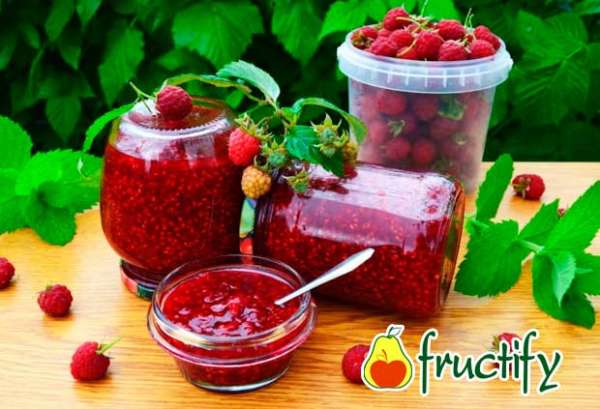
If raspberries and sugar are added in other proportions, the calorie content of the product will change. In different recipes it can vary from 200 to 350 kcal per 100 g. The calorie content of a spoonful of jam can be from 10 to 20 kcal.
In addition to traditional raspberry jam, raspberry jam is considered a popular homemade preparation for the winter. Its preparation differs from jam in that the berries are pre-chopped, so the texture of the product is more uniform and viscous. Depending on the quantity of raspberries and sugar added to the jam, its calorie content can range from 200 to 300 kcal. Accordingly, the calorie content of a teaspoon of jam will be from 10 to 15 kcal.
Another well-known recipe for preparing raspberries for the winter is the so-called “raw jam”. From “raw jam” you can prepare raspberry tea during the cold season, which has diaphoretic properties, strengthens the immune system and speeds up recovery.
The difference in its recipe is that the berries, ground with sugar, are not boiled, but in their raw form are placed in jars and stored in the refrigerator. The benefits of this delicacy are much greater than those of a traditional preparation, but the calories are the same.

Preparing raspberries for freezing
The most important stage. It affects the shelf life, taste, and color of future preparations for the winter. Do not freeze dirty, wrinkled raspberries with twigs. After thawing, it will not be possible to clean it; the output will be a dirty mess.
Step-by-step instruction:
- Sorting. Smooth, whole specimens are separated from soft, damaged berries.
- Washing. Place in a colander in portions. Carefully lower into a bowl of cold water and lift.
- Removing tails. Only after water procedures. Otherwise there will be a lot of water inside.
- Drying. An exceptionally thin layer on a napkin or towel. For some winter freezing recipes, a wet ingredient works.
It doesn't take long to dry. It is enough to let the water drain well, hold for half an hour, then immediately freeze. Soft specimens are often used wet, ground, crushed, and prepared into puree and raw jam for the winter.
Recipes for dietary dishes with raspberries
You can and should eat raspberries without harming your figure. But sweet jams and preserves are not suitable for this purpose. You know how many calories are in raspberries with sugar! To benefit from your health and figure, use our dietary recipes.
Raspberry ice cream
Delicious and healthy ice cream can be made without sugar or fat. All you need is 2 ingredients – raspberries and banana. The banana is peeled and broken into several small pieces. Raspberries can be used either fresh or frozen. The calorie content of frozen raspberries differs slightly from fresh fruits to a lesser extent, but not significantly, which does not greatly affect the total number of calories in the dessert.
Bananas and raspberries are placed in the freezer for 3 - 4 hours, until completely frozen. Then the frozen banana is pureed using a blender. Frozen fruit produces a puree that is soft in consistency and tastes like ice cream. Then raspberries are added to it and the whole mass is thoroughly crushed again with a blender. Ice cream can be topped with a teaspoon of raspberry syrup or decorated with chocolate shavings.
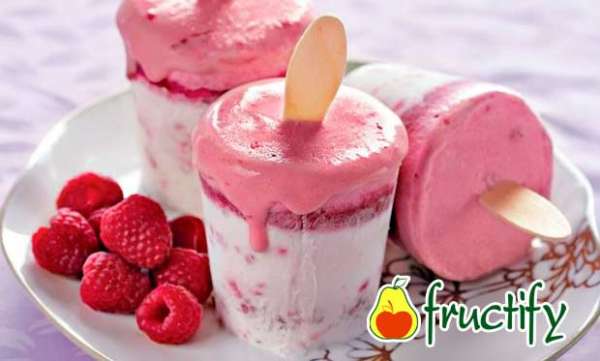
Raspberry trifle
Trifle is a dessert served in a glass. There are many recipes for trifles. During the season of fresh raspberries, you should definitely prepare a curd-raspberry trifle. For it you will need:
- for cream: soft low-fat cottage cheese (120 g), sweetener, vanillin;
- for the layer: 50 g fresh raspberries;
- for the crust: 1 egg, 20 g of rice flour, a pinch of salt, sweetener, baking powder, 2 teaspoons of low-fat sour cream.

The ingredients for the dough must be mixed thoroughly. A cupcake is baked from it in the microwave or oven. Soft cottage cheese is mixed with sweetener and vanillin. After cooling, the cake is cut into small cubes, take a glass and put the ingredients into it in layers: curd cream, sponge cake, berries, again cream, sponge cake and berries on top.
Raspberries in cosmetology
Raspberry berries and leaves are widely used in cosmetology. Its rich chemical composition is great for cleansing, nourishing and moisturizing the skin, smoothing out age and facial wrinkles, eliminating inflammation, pimples and acne.
Cosmetic mask
Mash 10-12 large raspberries with a fork and apply evenly to cleansed skin of the face, neck and décolleté. After 10-15 minutes, rinse with water at room temperature.

This mask, used 1-2 times a week, will smooth out wrinkles on your face, brighten your skin, make it elastic and smooth. Suitable for any skin type.
Raspberry leaf juice ointment
Mix 1 teaspoon of raspberry leaf juice with 4 teaspoons of Vaseline, mix thoroughly. Apply this ointment to red, irritated, acne-covered areas of the skin 3-4 times a day until inflammation decreases.
Raspberries for acne and inflammation
Mix 1 tablespoon of kefir with several raspberries, washed and mashed to a puree. Apply for 20 minutes to cleansed face and neck. After washing off the mask, use a moisturizer.
Thanks to this mask, the sebaceous glands begin to work normally, acne and inflammation disappear. It can be used no more than once a week.
Cleansing mask with raspberries
Puree of 10 raspberries is mixed with a tablespoon of red clay and a small amount of warm boiled water
The mass is evenly distributed over the face and neck, kept for 15-20 minutes, after which it is carefully washed off.
A mask based on red clay perfectly moisturizes and nourishes dry, dehydrated skin, cleanses the dead layer of cells, and gives an excellent complexion.
Before using raspberry masks, be sure to test all components on the crook of your elbow to avoid a possible allergic reaction.
